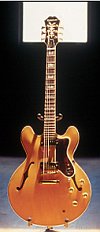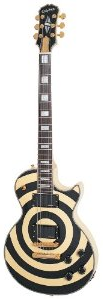Epiphone Electric Guitars...
A Major Comeback
Epiphone electric guitars and Epiphones in general were making great strides toward restoring Epiphone's
reputation and position in the market place as the 1990's rolled around. In order to make a full comeback,
however, there were a couple of issues that needed serious attention. The first was the lack of representatives
of Epiphone's legendary historic models. Even though Epiphone had 45 different models on offer, the lack of Epiphone's
famous models resulted in Epiphone being viewed as a faceless import.
and Epiphones in general were making great strides toward restoring Epiphone's
reputation and position in the market place as the 1990's rolled around. In order to make a full comeback,
however, there were a couple of issues that needed serious attention. The first was the lack of representatives
of Epiphone's legendary historic models. Even though Epiphone had 45 different models on offer, the lack of Epiphone's
famous models resulted in Epiphone being viewed as a faceless import.
The second issue, recognized by Dave Berryman who had taken control by this time, was the lack of Epiphone's own
dedicated office and workforce. Berryman initiated the acquisition of an office in Seoul, appointed Jim Rosenberg
as product manager and set about correcting the misconception that Epiphone was secondary to Gibson.
Epiphone Returns...
Berryman's efforts paid off big time. The Seoul office immediately began turning things around. No longer having to rely
on a long-distance relationship between management and the product, Epiphone management was now able to work directly with
its dedicated quality control staff at the factory. The direct involvement allowed Epiphone management to take a direct hand in everything
from factory processes and controls to guitar components themselves - pickups, bridges, toggle switches and any and everything
else that would make the Epiphone electric guitars special.
It paid off in a big way. One of the first fruits of Epiphone's efforts was a very successful limited-edition run of electric acoustics
which highlighted how far Epiphone had come. By 1993 there were more thin-bodied electric acoustics and a new range of PRs, hammering home
the impression that Epiphone was once again a leader instead of a follower.
Epiphone Noel Gallagher Supernova

Epiphone was looking to the past as well as the future. In 1993, a limited run of Riviera and Sheratons were produced in Gibson's Nashville factory,
with the company's Montana plant also building 250 Excellente, Texan and Frontier flat tops. These Epiphones were only intended as a special event
but the public reaction prompted Rosenberg to reissue many classic designs via the Korean range. 1994 NAMM saw the re-introduction of legends
including the Casino, Riviera, Sorrento and Rivoli bass. In the months that followed, word spread, and guitar luminaries including Chet Atkins and
Noel Gallagher signed up to the Epiphone cause - confirmation that these were instruments to be played through choice, not necessity.
Movin' On Up...
Epiphone was arguably as successful in the late 1990s as at any point in its history. With confidence running high, this era saw the launch
of the Advanced Jumbo Series and the release of several important signature models. The John Lee Hooker Sheratons from the USA Collection
were tasteful, toneful and totally authentic. The Noel Gallagher Supernovas had attitude and edge, and became some of the most iconic designs
of the time. Then there were the John Lennon 1965 and Revolution Casinos. With their US birthright, unbeatable authenticity and sense of aspiration,
these models reunited Epiphone electric guitars with one of the greatest artists of all time, and underlined the company's own re-emergence as a rock legend.
Epiphone 2002 Elitist

The momentum continued as the year 2000 came and went. Epiphone introduced the Elitist range and strengthened its position in the acoustic market
with the acquisition of veteran Gibson luthier Mike Voltz. Voltz's contribution to Epiphone's development cannot be overstated. While the Epiphone
electric guitar range had been revived to great acclaim, there was still a sense that it needed to regain its former reputation for world-beating
flat tops. The introduction of the Masterbilt range - along with the subsequent 2005 release of the Paul McCartney 1964 USA Texan - consolidated
Epiphone's acoustic credentials and reacquainted the firm with two big names from its past.
Epiphone 1964 Paul McCartney Texan

By 2003, the international demand for Epiphones was such that the company had opened a new factory in China. Not only did this mark the first time
that Epiphone had its own dedicated factory since the initial takeover by Gibson but staffed by US managers and luthiers, it also armed them with
the control over their own product that would let them take development to the next level, and give them a massive edge over the competition.
Epiphone Zakk Wylde Les Paul Custom

Nowadays Epiphone is all things to all players. Working musicians prize the company for its Gibson replicas, offering the quality of the most famous
US models at competitive prices.
Epiphone electric guitars are a great choice for guitarists of all genres. Collectors of vintage guitars snap up the authentic Elitist reissues of the Emperor, Casino and Excellente (and many more).
Recording artists turn to the Epiphone US range for quality that rivals any guitar manufacturer in the world, while rock 'n' roll fanatics delight in the
company's signature models, which include everything from the Nick Valensi Riviera to the Zakk Wylde Les Paul Customs. Regardless of budget, ability or musical
leaning, today's Epiphone line has it covered.
and Epiphones in general were making great strides toward restoring Epiphone's
reputation and position in the market place as the 1990's rolled around. In order to make a full comeback,
however, there were a couple of issues that needed serious attention. The first was the lack of representatives
of Epiphone's legendary historic models. Even though Epiphone had 45 different models on offer, the lack of Epiphone's
famous models resulted in Epiphone being viewed as a faceless import.












New! Comments
Have your say about what you just read! Leave me a comment in the box below.